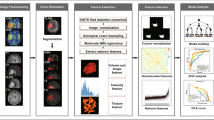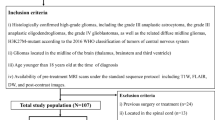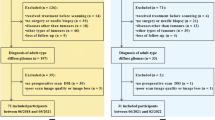Abstract
Purpose
EphA2 is a key factor underlying invasive propensity of gliomas, and is associated with poor prognosis of tumors. We aimed to develop a radiomics-based imaging index for predicting EphA2 expression in diffuse gliomas, and further estimating its value for grading of tumors.
Methods
A total of 182 patients with diffuse gliomas were included. All subjects underwent pre-operative MRI and post-operative pathological diagnosis. EphA2 expression of tumors was scored on pathological sections with immunohistochemical staining using monoclonal EphA2 antibody. MRI radiomics features were extracted from three-dimensional contrast-enhanced T1-weighted imaging and diffusion kurtosis imaging. Predictive models were constructed using machine learning–based radiomics features selection and three classifiers for predicting EphA2 expression and tumor grade. Features of best EphA2 expression model were subsequently used to construct another model of tumor grading. For each model, 146 cases (80%) were randomly picked as training and the rest 36 (20%) were testing cohorts. EphA2 expression was further correlated to the radiomics features in both grade models using Spearman’s correlation.
Results
Logistic regression model presented highest performance for predicting EphA2 expression (AUC: 0.836/0.724 in training/validation set). Tumor gradings model guided by features from EphA2 expression model demonstrated comparable performance (AUC: 0.930/0.983) to that constructed directly using imaging radiomics features (AUC: 0.960/0.977). Two radiomics features which included in both LR-grade models showed strong correlation (P < 0.05) with EphA2 expression.
Conclusion
The expression of EphA2 in gliomas could be predicted by radiomics features extracted from diffusion kurtosis MRI, which could also be used to assist tumor grading.






Similar content being viewed by others
Abbreviations
- EphA2:
-
Erythropoietin-producing hepatocellular receptor A2
- WHO:
-
World Health Organization
- 3DT1-CE:
-
Three-dimensional T1-weighted with contrasted enhancement
- DKI:
-
Diffusion kurtosis imaging
- LR:
-
Logistic regression
- SVM:
-
Support vector machine
- lightGBM:
-
Light gradient boosting machine
- ACC:
-
Accuracy
- SEN:
-
Sensitivity
- SPE:
-
Specificity
- AUC:
-
Area under curve
References
Ostrom QT, Cioffi G, Gittleman H et al (2019) CBTRUS statistical report: primary brain and other central nervous system tumors diagnosed in the United States in 2012–2016. Neuro Oncol 21:V1–V100
Van Der Geer P, Hunter T, Lindberg RA (1994) Receptor protein-tyrosine kinases and their signal transduction pathways. Annu Rev Cell Biol 10:251–337
Li X, Wang Y, Wang Y et al (2007) Expression of EphA2 in human astrocytic tumors: correlation with pathologic grade, proliferation and apoptosis. Tumor Biology 28:165–172
Liu F, Park PJ, Lai W et al (2006) A genome-wide screen reveals functional gene clusters in the cancer genome and identifies EphA2 as a mitogen in glioblastoma. Can Res 66:10815–10823
Wang L-F, Fokas E, Bieker M et al (2008) Increased expression. of EphA2 correlates with adverse outcome in primary and recurrent glioblastoma multiforme patients. Oncol Rep 19:151–156
Wu Q, Xu L, Wang C, Fan W, Yan H, Li Q (2018) MicroRNA-124-3p represses cell growth and cell motility by targeting EphA2 in glioma. Biochem Biophys Res Commun 503:2436–2442
Qazi MA, Vora P, Venugopal C et al (2018) Cotargeting ephrin receptor tyrosine kinases A2 and A3 in cancer stem cells reduces growth of recurrent glioblastoma. Can Res 78:5023–5037
Bielamowicz K, Fousek K, Byrd TT et al (2018) Trivalent CAR T cells overcome interpatient antigenic variability in glioblastoma. Neuro Oncol 20:506–518
Yi Z, Prinzing BL, Cao F, Gottschalk S, Krenciute G (2018) Optimizing EphA2-CAR T cells for the adoptive immunotherapy of glioma. Mol Ther-Methods Clin Dev 9:70–80
Pollack IF, Jakacki RI, Butterfield LH et al (2016) Antigen-specific immunoreactivity and clinical outcome following vaccination with glioma-associated antigen peptides in children with recurrent high-grade gliomas: results of a pilot study. J Neurooncol 130:517–527
Suo F, Zhong B, Lu F, Dong Z (2019) The combined use of EphA2/MMP-2 expression and MRI findings contributes to the determination of cerebral glioma grade. Oncol Lett 18:5607–5613
Lambin P, Leijenaar RTH, Deist TM et al (2017) Radiomics: the bridge between medical imaging and personalized medicine. Nat Rev Clin Oncol 14:749–762
Kim M, Jung SY, Park JE et al (2020) Diffusion- and perfusion-weighted MRI radiomics model may predict isocitrate dehydrogenase (IDH) mutation and tumor aggressiveness in diffuse lower grade glioma. Eur Radiol 30:2142–2151
Park CJ, Choi YS, Park YW et al (2020) Diffusion tensor imaging radiomics in lower-grade glioma: improving subtyping of isocitrate dehydrogenase mutation status. Neuroradiology 62:319–326
Li LF, Mu W, Wang YN et al (2019) A non-invasive radiomic method using F-18-FDG PET predicts isocitrate dehydrogenase genotype and prognosis in patients with glioma. Front Oncol 9:11
Lu CF, Hsu FT, Hsieh KLC et al (2018) Machine learning-based radiomics for molecular subtyping of gliomas. Clin Cancer Res 24:4429–4436
Kocak B, Durmaz ES, Ates E et al (2020) Radiogenomics of lower-grade gliomas: machine learning-based MRI texture analysis for predicting 1p/19q codeletion status. Eur Radiol 30:877–886
Han YQ, Xie Z, Zang YL et al (2018) Non-invasive genotype prediction of chromosome 1p/19q co-deletion by development and validation of an MRI-based radiomics signature in lower-grade gliomas. J Neurooncol 140:297–306
Jiang CD, Kong ZR, Liu SR et al (2019) Fusion radiomics features from conventional MRI predict MGMT promoter methylation status in lower grade gliomas. Eur J Radiol 121:108714
Sasaki T, Kinoshita M, Fujita K et al (2019) Radiomics and MGMT promoter methylation for prognostication of newly diagnosed glioblastoma. Sci Rep 9:14435
Van Cauter S, Veraart J, Sijbers J et al (2012) Gliomas: diffusion kurtosis MR imaging in grading. Radiology 263:492–501
Wang X, Li F, Wang D, Zeng Q (2020) Diffusion kurtosis imaging combined with molecular markers as a comprehensive approach to predict overall survival in patients with gliomas. Eur J Radiol 128:108985
Jiang R, Jiang J, Zhao L et al (2015) Diffusion kurtosis imaging can efficiently assess the glioma grade and cellular proliferation. Oncotarget 6:42380–42393
Zhao J, Wang YL, Li XB et al (2019) Comparative analysis of the diffusion kurtosis imaging and diffusion tensor imaging in grading gliomas, predicting tumour cell proliferation and IDH-1 gene mutation status. J Neurooncol 141:195–203
Cheng N, Brantley DM, Liu H et al (2002) Blockade of EphA receptor tyrosine kinase activation inhibits vascular endothelial cell growth factor-induced angiogenesis. Mol Cancer Res 1:2–11
Ogawa K, Pasqualini R, Lindberg RA, Kain R, Freeman AL, Pasquale EB (2000) The ephrin-A1 ligand and its receptor, EphA2, are expressed during tumor neovascularization. Oncogene 19:6043–6052
Tan Y, Mu W, Wang XC, Yang GQ, Gillies RJ, Zhang H (2020) Whole-tumor radiomics analysis of DKI and DTI may improve the prediction of genotypes for astrocytomas: a preliminary study. Eur J Radiol 124:7
Thaker PH, Deavers M, Celestino J et al (2004) EphA2 expression is associated with aggressive features in ovarian carcinoma. Clin Cancer Res 10:5145–5150
Lin YG, Han LY, Kamat AA et al (2007) EphA2 overexpression is associated with angiogenesis in ovarian cancer. Cancer 109:332–340
Quentin M, Pentang G, Schimmoeller L et al (2014) Feasibility of diffusional kurtosis tensor imaging in prostate MRI for the assessment of prostate cancer: preliminary results. Magn Reson Imaging 32:880–885
Hansen B, Shemesh N, Jespersen SN (2016) Fast imaging of mean, axial and radial diffusion kurtosis. Neuroimage 142:371–383
Glenn GR, Helpern JA, Tabesh A, Jensen JH (2015) Quantitative assessment of diffusional kurtosis anisotropy. NMR Biomed 28:448–459
van Griethuysen JJM, Fedorov A, Parmar C et al (2017) Computational radiomics system to decode the radiographic phenotype. Can Res 77:E104–E107
Delong ER, Delong DM, Clarkepearson DI (1988) Comparing the areas under 2 or more correlated receiver operating characteristic curves - a nonparametric approach. Biometrics 44:837–845
Miao H, Gale NW, Guo H et al (2015) EphA2 promotes infiltrative invasion of glioma stem cells in vivo through cross-talk with Akt and regulates stem cell properties. Oncogene 34:558–567
Miao H, Li D-Q, Mukherjee A et al (2009) EphA2 mediates ligand-dependent inhibition and ligand-independent promotion of cell migration and invasion via a reciprocal regulatory loop with Akt. Cancer Cell 16:9–20
Zhang J, Chen X, Chen D, Wang Z, Li S, Zhu W (2018) Grading and proliferation assessment of diffuse astrocytic tumors with monoexponential, biexponential, and stretched-exponential diffusion-weighted imaging and diffusion kurtosis imaging. Eur J Radiol 109:188–195
Cho HH, Lee SH, Kim J, Park H (2018) Classification of the glioma grading using radiomics analysis. Peerj 6:e5982
Su CL, Jiang JJ, Zhang S et al (2019) Radiomics based on multicontrast MRI can precisely differentiate among glioma subtypes and predict tumour-proliferative behaviour. Eur Radiol 29:1986–1996
Ditmer A, Zhang B, Shujaat T et al (2018) Diagnostic accuracy of MRI texture analysis for grading gliomas. J Neurooncol 140:583–589
Qi X-X, Shi D-F, Ren S-X et al (2018) Histogram analysis of diffusion kurtosis imaging derived maps may distinguish between low and high grade gliomas before surgery. Eur Radiol 28:1748–1755
Tietze A, Hansen MB, Ostergaard L et al (2015) Mean diffusional kurtosis in patients with glioma: initial results with a fast imaging method in a clinical setting. Am J Neuroradiol 36:1472–1478
Funding
This study was funded by the National Key Technology (R&D) Program of the Ministry of Science and Technology (2018YFA0701703 to Z.Z.); National Natural Science Foundation of China (81530054 to G.L., 81830056 to F.S.); grants of the key talent project in Jiangsu province (ZDRCA2016093 to Z.Z.); Natural scientific foundation-social development (BE2016751 to Z.Z.); Post-doctoral grants of China (2016M603064 to Z.Z.) and Jiangsu Province (1501169B to Z.Z.); health system strengthening project with Science and Education of Jiangsu provincial Commission of Health and Family Planning (YXZXA2016007 to G.L.).
Author information
Authors and Affiliations
Corresponding author
Ethics declarations
Conflict of interest
Q.Z., Y.T., and F.S. are employees of Shanghai United Imaging Intelligence Co., Ltd. The company has no role in designing and performing the surveillances and analyzing and interpreting the data. All other authors report no conflicts of interest relevant to this article.
Ethics approval
All procedures performed in the studies involving human participants were in accordance with the ethical standards of the institutional and/or national research committee and with the 1964 Helsinki Declaration and its later amendments or comparable ethical standards.
Informed consent
Informed consent was obtained from all individual participants included in the study.
Additional information
Publisher’s note
Springer Nature remains neutral with regard to jurisdictional claims in published maps and institutional affiliations.
Key Points
1. EphA2 plays an important role in the occurrence and development of glioma.
2. We developed a radiomics-based index of EphA2 expressing in diffuse glioma.
3. The prediction model showed high diagnostic performance in predicting glioma’s grade.
4. Associations were found between the top features in the model predicting EphA2 and that for tumor grading.
Supplementary Information
Below is the link to the electronic supplementary material.
Rights and permissions
About this article
Cite this article
Liu, X., Li, J., Liao, X. et al. Radiomics-based MRI for predicting Erythropoietin-producing hepatocellular receptor A2 expression and tumor grade in brain diffuse gliomas. Neuroradiology 64, 323–331 (2022). https://doi.org/10.1007/s00234-021-02780-1
Received:
Accepted:
Published:
Issue Date:
DOI: https://doi.org/10.1007/s00234-021-02780-1




